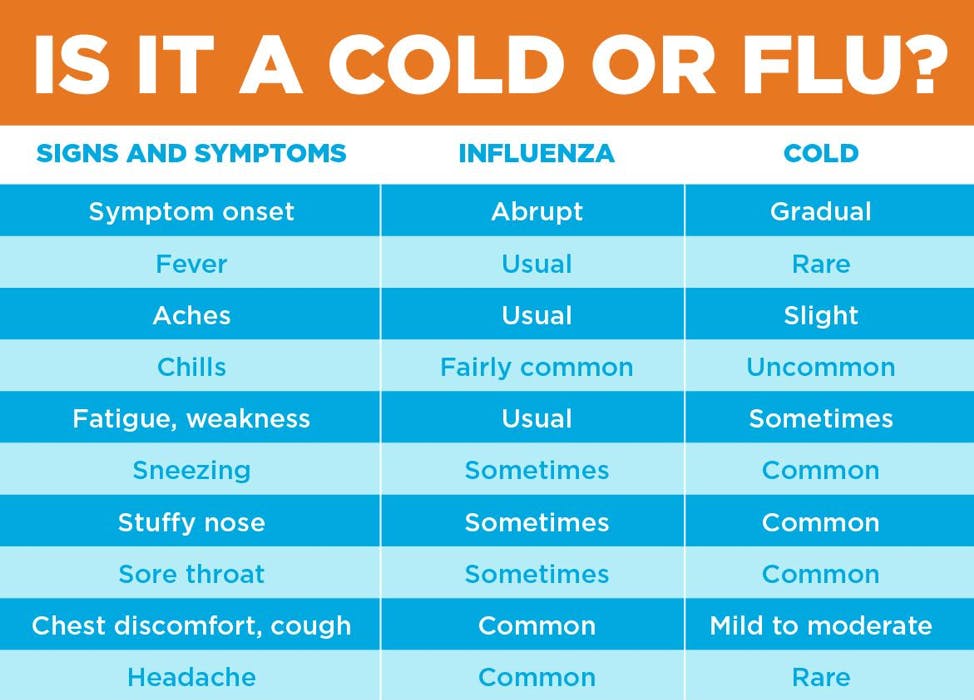Flu vs. Cold symptoms: Understanding the difference
Although the cold and the flu are both respiratory illnesses, they are caused by different viruses. Comparing the symptoms is usually the best way to tell which ailment you may have.
A cold can cause a sore throat, cough and runny or stuffy nose. Generally speaking, flu symptoms are similar but more severe. In addition to those symptoms, influenza (the flu) can cause fever, chills, muscle or body aches, headaches and fatigue. Influenza can also result in more serious health problems, such as pneumonia and lead to secondary bacterial infections.
What is the common cold?
Like the flu, the common cold is a respiratory virus that usually lasts for about a week. Although uncomfortable, cold symptoms are generally not as severe as flu symptoms.
Similar to the flu, the common cold is also contagious. It’s easily spread to others, so while you are coughing and blowing your nose, even if you don’t feel that sick, it’s best to work from home if possible, and stay away from those who are likely to get sicker, like pregnant women and adults over 65. A little rest will do you good, and it will help aid in your recovery.
Common cold diagnosis
There is no test to diagnose a common cold. Typically, a diagnosis is made by ruling out other illnesses and evaluating symptoms. If you are unsure if you have a common cold, the flu, COVID-19 or RSV, a healthcare provider can help you get the appropriate testing and diagnosis.
What is the flu?
The flu is a viral respiratory infection caused by the influenza virus. It is a contagious virus that can cause moderate to severe illness, including death. Common flu symptoms include:
- Body aches
- Cough
- Fatigue
- Fever
- Headaches
- Sore throat
- Stuffy nose
Flu diagnosis
It's sometimes impossible to tell if it’s the flu or another respiratory virus without a medical professional performing a diagnostic test within the first few days of illness. Your healthcare provider can prescribe antiviral medications to lessen the symptoms, but they are most effective when administered within two days of onset.
Who’s more at risk of getting the flu?
Regardless of age or preexisting health conditions, anyone can get the flu. However, some people are more at risk of not only getting the flu but also contracting serious conditions because of it:
● People 65 and older
● People with chronic medical conditions
● Pregnant women
● Young children
That’s why getting a flu shot before influenza season begins is so important. It’s the best way to avoid the flu and to help protect others from getting it.
How to distinguish a cold from the flu
When comparing flu vs cold symptoms, note these three key differences:
- Onset: The flu comes on quickly, while a cold develops gradually, usually with a sore throat and runny nose.
- Fever: A common cold rarely includes a fever of more than 101 F. However, flu symptoms usually include an initial fever. Cough, body, and muscle aches are also more common with the flu.
- Timing: Flu season generally lasts from fall to spring of the following year, but a cold can happen at any time of the year.
Cold vs. flu symptoms chart
Here is an easy-to-understand cold and flu chart to help you understand the symptoms.

Image Source: https://www.cdc.gov/flu/about/qa/coldflu.htm
Cold and flu differences in children
Children generally experience symptoms similar to those of adults when they have a cold or flu. However, they are more likely to have vomiting and diarrhea with the flu, which is not as common in adults. They may also have higher fevers.
If your child has a cold or the flu, it is important to monitor them for worsening symptoms, as they might be unable to communicate what they are feeling. These symptoms can include:
- Blue lips
- Chest pain
- Dehydration
- Difficulty breathing
- Fever over 104 F
- Lethargic
- Severe muscle pain
- Seizures
If your child is experiencing any of these symptoms, they need immediate emergency medical attention.
Common cold and flu FAQs
Here are some frequently asked questions about the flu vs colds.
What are the stages of a cold?
The stages of a cold are the incubation period, the appearance of symptoms, remission, and recovery. Typically, it takes about seven to ten days to move through all of these phases.
When is the best time to get a flu shot?
It is best to take the flu shot in September or October or before flu season begins. Building immunity takes about two weeks.
How long will a common cold last?
Cold symptoms can last between seven to ten days. A cough may linger for up to two weeks. Comparatively, how long does the flu last? The flu lasts about the same amount of time, although some symptoms, like the cough from the flu, can linger for two weeks or longer.
How can the common cold be prevented?
The best way to prevent the common cold is also to lower your risk of any viral infection. A few prevention measures can include:
- Get an annual flu shot
- Wash your hands with soap and water, especially before mealtime
- Avoid touching your eyes, nose, and mouth
- Stay away from others who are sick
- Cough or sneeze into a tissue
- Stay home if you are sick
Visit an urgent care center near you for cold or flu symptoms
If you’re experiencing any of these symptoms, the caring providers can perform a rapid flu test to determine if you’ve got a case of the sniffles or something more serious.
To get started, find the urgent care center nearest you and walk in or save your spot online.
References:


